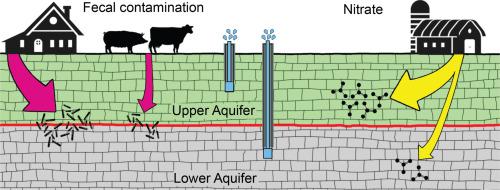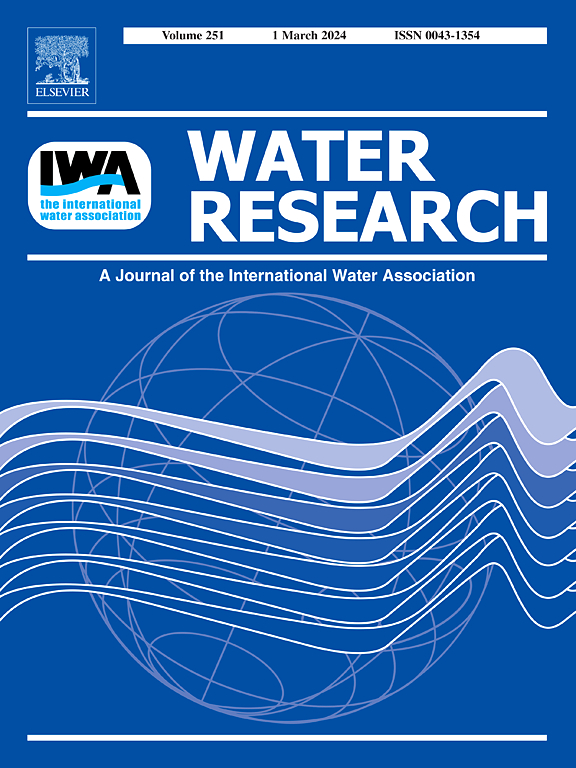Sources and risk factors for nitrate, pathogens, and fecal contamination of private wells in rural southwestern Wisconsin, USA
IF 11.4
1区 环境科学与生态学
Q1 ENGINEERING, ENVIRONMENTAL
引用次数: 0
Abstract
Household well water can be degraded by contaminants from the land's surface, but private well owners lack means to protect the source water from neighboring disturbances. Rural residents of southwestern Wisconsin, USA, rely on private well water, and the combination of land use and fractured carbonate bedrock makes groundwater vulnerable to contamination. To identify the extent, sources, and risk factors of private well contamination, randomly selected wells sampled during two-day periods in fall (n = 301) and spring (n = 529) were analyzed for nitrate and indicator bacteria, and a subset (n = 138) was sampled across four seasonal events for analysis of pathogens and microbial source tracking markers by quantitative polymerase chain reaction. Risk factors representing land use, hydrology, geology, and well construction were analyzed for associations with contamination in multivariable models. The importance of risk factors varied by contaminant, illustrating the multifaceted nature of rural groundwater quality. Nitrate contamination was associated with agricultural land use, and wells with casings that extended below a shale aquitard accessed less contaminated water than those drawing water from above it. Human fecal microbes were detected in 64 wells (46%), and rainfall was the key risk factor for contamination, indicating that wastewater from septic systems was available to contaminate wells when transport conditions were favorable. Manure microbes from cattle/ruminants and pigs were detected in 33 and 13 wells, respectively, and concentrations increased with the hectarage of cultivated land near wells. Pathogen genes for viruses, bacteria, and protozoa were detected in 66 wells (48%), including more detections of zoonotic than human-specific pathogens, and human Bacteroides, an indicator of wastewater, was an equivocal predictor of pathogen presence in private wells. Characterizing important elements of the setting, like geology, and identifying sources and risk factors for contaminants can inform landscape-level policies to protect groundwater quality.

求助全文
约1分钟内获得全文
求助全文
来源期刊

Water Research
环境科学-工程:环境
CiteScore
20.80
自引率
9.40%
发文量
1307
审稿时长
38 days
期刊介绍:
Water Research, along with its open access companion journal Water Research X, serves as a platform for publishing original research papers covering various aspects of the science and technology related to the anthropogenic water cycle, water quality, and its management worldwide. The audience targeted by the journal comprises biologists, chemical engineers, chemists, civil engineers, environmental engineers, limnologists, and microbiologists. The scope of the journal include:
•Treatment processes for water and wastewaters (municipal, agricultural, industrial, and on-site treatment), including resource recovery and residuals management;
•Urban hydrology including sewer systems, stormwater management, and green infrastructure;
•Drinking water treatment and distribution;
•Potable and non-potable water reuse;
•Sanitation, public health, and risk assessment;
•Anaerobic digestion, solid and hazardous waste management, including source characterization and the effects and control of leachates and gaseous emissions;
•Contaminants (chemical, microbial, anthropogenic particles such as nanoparticles or microplastics) and related water quality sensing, monitoring, fate, and assessment;
•Anthropogenic impacts on inland, tidal, coastal and urban waters, focusing on surface and ground waters, and point and non-point sources of pollution;
•Environmental restoration, linked to surface water, groundwater and groundwater remediation;
•Analysis of the interfaces between sediments and water, and between water and atmosphere, focusing specifically on anthropogenic impacts;
•Mathematical modelling, systems analysis, machine learning, and beneficial use of big data related to the anthropogenic water cycle;
•Socio-economic, policy, and regulations studies.
 求助内容:
求助内容: 应助结果提醒方式:
应助结果提醒方式:


